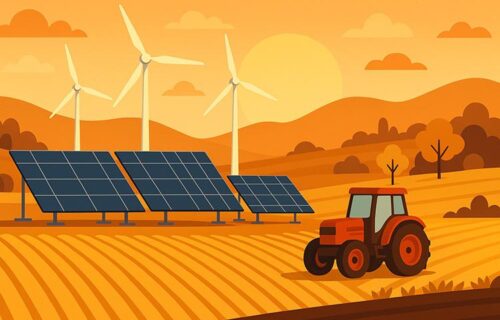Romania’s renewable energy transition gained fresh momentum in the first half of 2025, with both prosumer households and the agricultural sector accelerating their adoption of solar and biogas systems. The surge is reshaping not only rural energy consumption but also creating ripple effects for investors, developers, and the country’s broader real estate landscape.
According to data from the National Energy Regulatory Authority (ANRE), Romania counted more than 228,000 registered prosumers by the end of May 2025, with a combined installed capacity of 2,726 MW. That marks a 66 percent jump in numbers and a 53 percent increase in capacity compared to the same period last year. Ilfov county leads the way with almost 15,400 installations, followed by Timiș with more than 11,000 and Bihor with roughly 9,400. While households dominate by volume, businesses and industrial users hold a growing share of capacity, underscoring a shift from residential rooftops to commercial-scale applications.
This growth has been supported by generous grant schemes. The Agency for Financing Rural Investments (AFIR) launched a €150 million funding program for farms and food processors, covering up to 100 percent of eligible project costs. Most of the budget targets solar systems under one megawatt, aligning with the needs of medium-sized agricultural operators. “For farms, solar is no longer a side investment — it’s becoming central to cost control,” said one Bucharest-based energy consultant. “With grant coverage this high, we’re seeing interest not just from large agribusinesses but also from smaller family operations looking to stabilize margins.”
On the generation side, Romania added around 900 MW of new solar capacity in the first half of 2025, bringing the national total to approximately 4.2 GW. That positions the country firmly on track toward its National Energy and Climate Plan target of 10 GW by 2030. Analysts note that much of the recent growth is being delivered at distribution level, where grid capacity is under pressure in certain counties. “Investors are watching carefully how quickly upgrades and storage projects can catch up, as bottlenecks could otherwise limit deployment,” one regional developer told CIJ EUROPE.
Romania’s real estate and infrastructure sectors are beginning to feel the impact of this renewable wave. New warehouse and logistics parks in regional cities increasingly market themselves with onsite generation or green power procurement, while farmland values in solar-rich counties are benefiting from dual-use potential. Developers point to Ilfov, Timiș and Bihor as front-runners in terms of grid access and renewable integration, creating fresh opportunities for landowners.
Looking forward, Romania’s farm sector is expected to diversify beyond photovoltaics. A landmark 15 MW biomethane project under development by Black Sea Oil & Gas and DN Agrar aims to become the country’s first large-scale facility of its kind, cutting emissions by about 90 percent at one of the nation’s largest livestock farms. Such projects signal how agriculture can contribute not only to self-consumption but also to the decarbonisation of heating and transport fuels.
For investors, the momentum is clear: prosumer demand is surging, subsidy frameworks are generous, and utility-scale projects are accelerating. The challenge lies in ensuring grid stability and regulatory clarity. If those can be secured, Romania’s renewable build-out may position the country as a key Eastern European hub, bridging rural development, energy security, and new opportunities for real estate-linked infrastructure.
Sources: comp.
